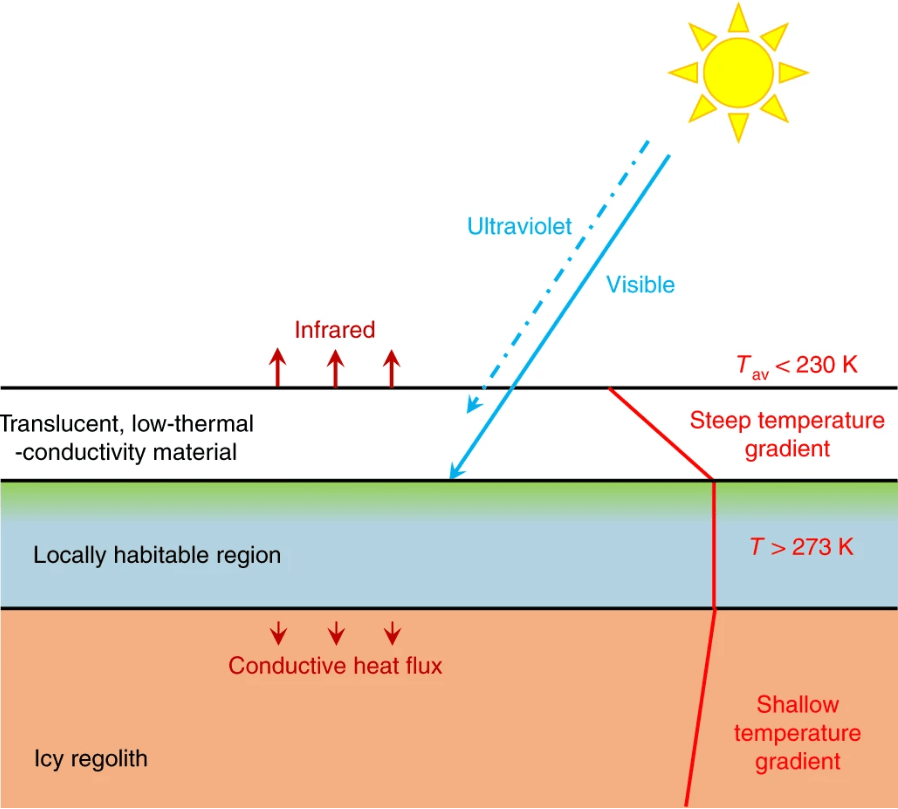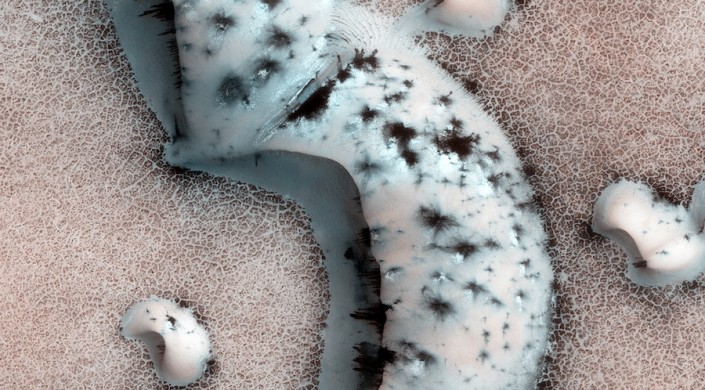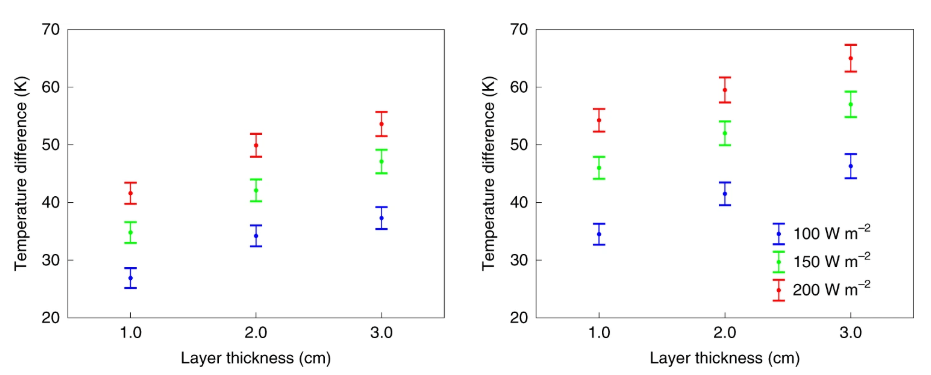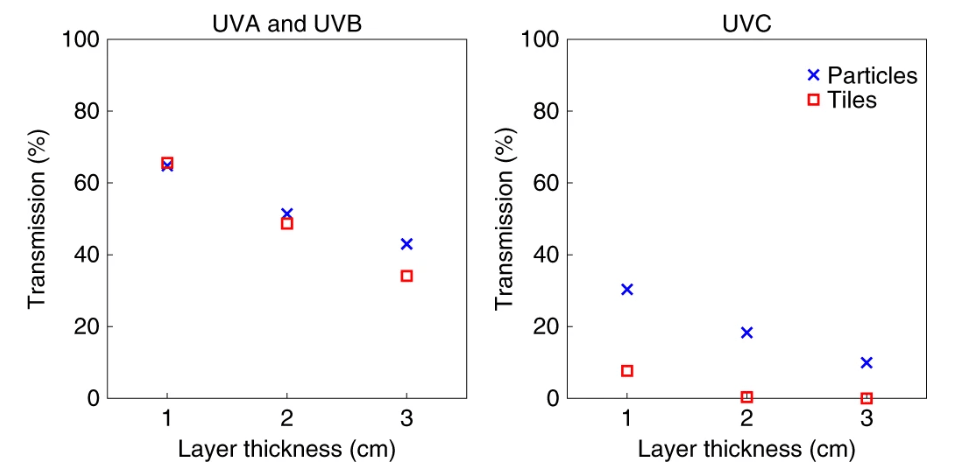The idea of somehow terra-forming Mars to make it more habitable is a visionary, sci-fi dream. But though global terra-forming of Mars is out of reach, the idea persists. But now, a material called silica aerogel might make make the whole idea of terra-forming Mars slightly less impossible.
Notable people from Carl Sagan to Elon Musk have proposed warming Mars and give it an atmosphere, and the trick lies in the frozen CO2 and water in the planet’s polar caps. Sagan said if those caps could be vaporized somehow, then the CO2 greenhouse effect would do the rest. Musk said, glibly and half-jokingly, that atomic bombs dropped on the poles would do the trick.
There’s serious scientific work going on to explore the idea, at least in theory. The central question is, does Mars have enough CO2 and water to create an atmospheric density similar to Earths?

In 2018, scientists at the University of Colorado studied the question. Their conclusion? Terraforming Mars is not possible with our current technology, something that most people already felt certain was true.
“Our results suggest that there is not enough CO2 remaining on Mars to provide significant greenhouse warming were the gas to be put into the atmosphere; in addition, most of the CO2 gas is not accessible and could not be readily mobilized. As a result, terraforming Mars is not possible using present-day technology,” said Bruce Jakosky, professor at the Laboratory of Atmosphere and Space Physics at University of Colorado, Boulder.
But that was a year ago, and technology is constantly evolving.
In a new study in Nature Astronomy, a trio researchers from NASA’s Jet Propulsion Laboratory, Harvard University, and the University of Edinburgh, suggest that Mars could be made habitable if we change our thinking and use new technology. Rather than grand dreams of making the entirety of the red planet habitable, what scientists call Global Atmospheric Modification (GAM,) what if small regions could be transformed?
The key behind their line of thinking is silica aerogel.
“This regional approach to making Mars habitable is much more achievable than global atmospheric modification.”
Robin Wordsworth, Harvard John A. Paulson School of Engineering and Applied Sciences
Silica aerogel is not what you might think it is. Rather than an actual gel, it’s a solid, rigid, dry material. It’s created by extracting the liquid from a gel with a process called supercritical drying, the same process used make decaffeinated coffee.
The researchers behind this new study used models and experiments to show that a thin, 2 to 3 cm (.8 to 1.2 inch) layer of aerogel could allow sunlight to penetrate, but would trap heat. The gel would also allow enough sunlight for photosynthesis, and would permanently warm the area it covered, allowing water ice and frozen CO2 to melt. Maybe best of all, it wouldn’t need an energy-hungry heat source to do so.

“This regional approach to making Mars habitable is much more achievable than global atmospheric modification,” said Robin Wordsworth, Assistant Professor of Environmental Science and Engineering at the Harvard John A. Paulson School of Engineering and Applied Sciences (SEAS) and the Department of Earth and Planetary Science. “Unlike the previous ideas to make Mars habitable, this is something that can be developed and tested systematically with materials and technology we already have,” he said in a press release.
“Small Islands of Habitability”
“Mars is the most habitable planet in our Solar System besides Earth,” said Laura Kerber, Research Scientist at NASA’s Jet Propulsion Laboratory. “But it remains a hostile world for many kinds of life. A system for creating small islands of habitability would allow us to transform Mars in a controlled and scalable way.”
The silica aerogel, island of habitability idea was inspired by something that already occurs at Mars’ poles.
Unlike on Earth, the CO2 on Mars is frozen, trapped at the poles. While here on Earth the poles are water ice, the Martian poles are a combination of water ice and CO2 ice. But even though it’s frozen, that CO2 still allows sunlight to penetrate while trapping the heat.
Images of Mars’ poles show how this happens.
In this image of ice on Mars, the CO2 has trapped the Sun’s warmth. This creates little pockets of warmth in the summer, which show up as black melted spots in the ice.

“We started thinking about this solid-state greenhouse effect and how it could be invoked for creating habitable environments on Mars in the future,” said Wordsworth. “We started thinking about what kind of materials could minimize thermal conductivity but still transmit as much light as possible.”
As it turns out, silica aerogel fits the bill. It was first invented in 1931, and it’s one of the most highly-insulating materials ever made. That’s because it’s a very porous material that is almost completely made of air. It’s about 99.8% air, kind of like a thermal window.
Silica aerogels are 97 percent porous, meaning light moves through the material but the interconnecting nanolayers of silicon dioxide trap infrared radiation and greatly slow the conduction of heat. These aerogels are used in several engineering applications today, including NASA’s Mars Exploration Rovers. They’re used to keep the sensitive electronics warm.
“Silica aerogel is a promising material because its effect is passive,” said Kerber. “It wouldn’t require large amounts of energy or maintenance of moving parts to keep an area warm over long periods of time.”
The researchers set up experiments to mimic conditions on Mars. They experimented with two types of silica aerogel: particles and tiles. They found that both were effective at raising the temperature. Both were also effective at blocking dangerous UV radiation.


Their results show that a 2 cm or more layer of aerogel reduced UVC radiation to less than 0.5%. UVC is higher-energy UV radiation, and can be particularly harmful. On Earth, almost no measurable UVC radiation reaches the surface due to ozone, molecular oxygen and water vapor in the upper atmosphere.
“Spread across a large enough area, you wouldn’t need any other technology or physics, you would just need a layer of this stuff on the surface and underneath you would have permanent liquid water,” said Wordsworth. “There’s a whole host of fascinating engineering questions that emerge from this.”
It’s easy enough to envision some kind of dome structure made of silica aerogel. It would be warm enough to be habitable, and would also block out UV. It could be kind of like a greenhouse on Earth, where water remained as liquid and plants could be grown.
There’s a lot more work and research to be done, obviously. Wordsworth and the other researchers intend to test silica aerogels at Mars-like locations here on Earth. They’re targeting dry valley in Chile and Antarctica.
Wordsworth is clear on one thing: engineering the climate of Mars is not just a technical and engineering question. It’s an ethical and philosophical question, too.
If there’s already some microbes living on Mars, perhaps under the surface somewhere, what about them? Should we do it? Do we have the right?
“If you’re going to enable life on the Martian surface, are you sure that there’s not life there already? If there is, how do we navigate that,” asked Wordsworth. “The moment we decide to commit to having humans on Mars, these questions are inevitable.”
Sources:
- Research Paper: Enabling Martian habitability with silica aerogel via the solid-state greenhouse effect
- Press Release: A material way to make Mars habitable
- Press Release: Mars terraforming not possible using present-day technology
- Wikipedia: Aerogel
- Universe Today: Should We Terraform Mars?
